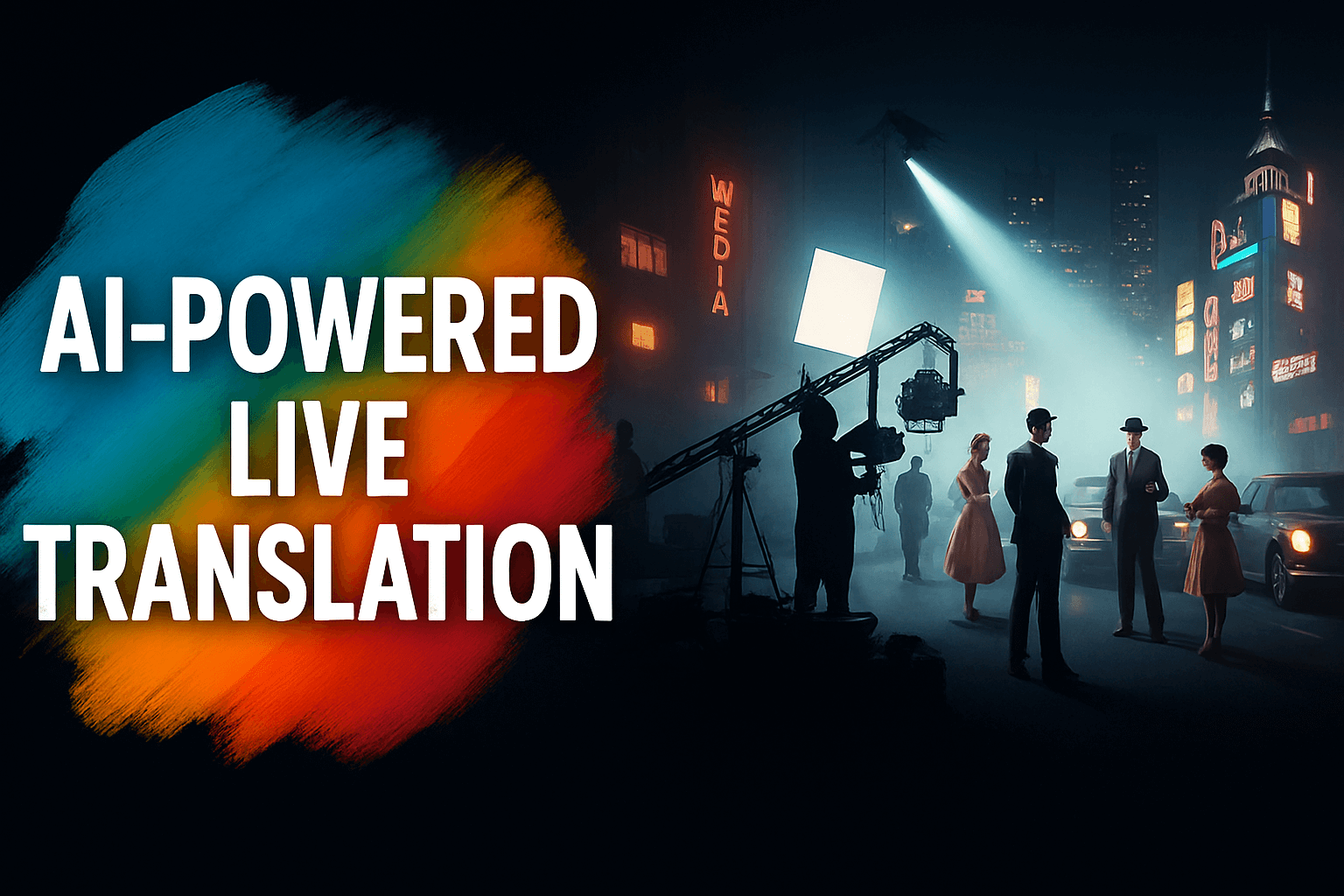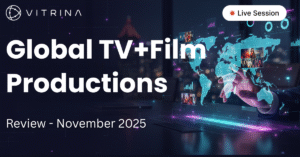AI-Powered Live Translation for Global Content

Introduction
In the world of broadcasting, live content is the ultimate premium. It is where audiences connect, communities are formed, and history is made. Yet, for decades, language barriers and a lack of accessibility have limited this experience to a single language, a single audience, and a single market.
The global localization market, which reached a valuation of approximately $71.7 billion in 2024, has been dominated by slow, manual, and expensive processes that have made live translation and captioning a logistical impossibility.
For a senior executive, this has created a powerful challenge: how do you cost-effectively and seamlessly deliver live, real-time content to a global audience of billions?
This article will provide a strategic framework for understanding the live translation revolution, revealing how AI is now a force for inclusion and accessibility, making real-time, multilingual broadcasts a reality for a fraction of the traditional cost. I will show you how a platform like Vitrina can act as a force multiplier, enabling you to find and vet the right partners to scale your live content strategy.
Table of content
- The Live Revolution: Why Real-Time Translation is a Strategic Imperative
- The Power of AI: Delivering Broadcast Quality for a Fraction of the Cost
- Mission-Driven Innovation: How AI is Redefining Inclusion and Accessibility
- How Vitrina Empowers Live Translation Partnerships
- Conclusion: The Future of Global Storytelling is Here
- Frequently Asked Questions
Key Takeaways
| Core Challenge | The high cost and logistical complexity of traditional live translation have created a significant barrier to global audience reach and accessibility. |
| Strategic Solution | Leverage AI-powered, human-free live translation and captioning to deliver real-time, multilingual content at scale, speed, and a fraction of the cost. |
| Vitrina’s Role | Vitrina provides the verified intelligence on AI providers and technology partners needed to find and vet the right collaborators to accelerate your live content strategy. |
The Live Revolution: Why Real-Time Translation is a Strategic Imperative
The demand for live content, from sports and breaking news to corporate town halls, is a global phenomenon. However, for decades, the localization of live content has been a logistical and financial impossibility. Traditional methods required teams of human interpreters and a costly, time-intensive process that made real-time delivery a non-starter.
This created a powerful paradox: while live events have the greatest potential for global engagement, they were often limited to a single language and a single market. The emergence of AI has solved this problem, leading to a live translation revolution that is disrupting the entire broadcast supply chain.
As Tony Abrahams, CEO of Ai-Media, explains, his company has moved beyond captioning to become a “workflow orchestration company embedding AI” into its clients’ systems. The focus is now squarely on “live,” with a suite of products designed to handle real-time broadcasts, sports, and events—not just episodic or archival content.
The core innovation is AI’s ability to automate the entire localization workflow in real-time. Ai-Media’s flagship product, Lexi Voice, can translate live TV broadcasts into over 100 different languages with a latency of less than 10 seconds.
The result is a natural-sounding voice translation that is seamlessly synced with the original content, without the need for human interpreters or transcriptionists.
This technology is built on a robust broadcast infrastructure, with over 6,000 encoders deployed across U.S. broadcasters, making it a plug-and-play solution that is designed for seamless integration.
The Power of AI: Delivering Broadcast Quality for a Fraction of the Cost
One of the biggest breakthroughs in live translation is the pricing model that AI-powered solutions have made possible. Traditional live translation and interpretation could cost thousands of dollars per hour. Ai-Media’s Lexi Voice is priced at just $30 per hour, per language pair, a price point that is a “game changer” for the industry.
This revolutionary cost efficiency makes live translation accessible to a much broader range of clients, from major sports leagues to regional news broadcasters. For a broadcaster, the ROI is immediate and tangible; just a few more viewers clicking on ads can cover the cost of a full, multilingual broadcast.
This business model is built on an AI-driven, human-free workflow that is both scalable and cost-efficient. It is not a replacement for human talent in the creative process, but rather a strategic tool that automates the logistical, repetitive tasks of transcription and translation. This allows broadcasters to attract broader and more diverse audiences without the burden of massive production costs.
This model is gaining traction globally, with a strong presence in U.S. broadcast and a growing footprint in Europe, driven by key partnerships that have validated the technology’s effectiveness.
Mission-Driven Innovation: How AI is Redefining Inclusion and Accessibility
The impact of AI-powered accessibility goes far beyond cost savings and global reach. It is a powerful force for social good. Ai-Media’s journey began with a mission to improve accessibility, and its live captioning technology has had a transformative impact on education.
Back in 2007, half of all deaf students never completed high school; today, that number has flipped, with 90% now graduating because they have access to real-time English in classrooms. This is a powerful example of how technology, when thoughtfully applied, can redefine inclusion and transform lives.
The same principles of accessibility and inclusion are now being applied to live translation. By making live sports, breaking news, and educational content available in over 100 languages, AI is breaking down language barriers and extending the reach of vital information to a global audience.
This mission-driven approach is a key differentiator for companies that are not just building technology for technology’s sake but are focused on solving real-world problems and creating a more connected and equitable world.
For more on how Ai-Media is leading the charge in live translation, read this in-depth case study.
How Vitrina Empowers Live Translation Partnerships
For an executive seeking to implement a live translation strategy, the key is to find a partner that can deliver not just a technology, but a reliable, integrated solution.
The market is filled with a multitude of providers, and it can be difficult to vet their capabilities and understand their specializations. Vitrina provides a single source of truth that simplifies this process.
The platform’s comprehensive database of media technology companies, including AI localization providers like Ai-Media, allows you to quickly identify and vet potential partners based on a variety of criteria.
By leveraging Vitrina’s rich metadata, you can search for companies specializing in live translation, auto-captioning, and speech-to-speech translation. You can see their areas of expertise, their partnerships with major broadcasters and sports leagues, and their track record of success, giving you the confidence to make an informed decision.
This strategic approach to partner discovery is essential for any executive looking to implement an AI-driven localization strategy. Vitrina empowers you to build a highly qualified business pipeline, ensuring your next investment in technology is a strategic one that enhances your global reach and monetization potential.
Conclusion: The Future of Global Storytelling is Here
The live translation revolution is a defining moment for the broadcast industry. AI is no longer just a buzzword; it is a strategic tool that is democratizing accessibility and unlocking the potential of live content for a global audience.
The ability to deliver real-time, multilingual broadcasts at a fraction of the traditional cost is a game-changer for broadcasters, sports leagues, and enterprises alike. It is a powerful example of how thoughtful application of technology can not only transform a business model but also redefine inclusion and connection on a global scale.
To navigate this new landscape, you need a partner. Vitrina provides the essential data and connectivity to help you find the right technology providers and make the right strategic moves. By leveraging a single source of truth, you can confidently build a content ecosystem that is built for the future.
Ready to make smarter, faster decisions in the new era of content production? Sign-up Today
Frequently Asked Questions
Live translation is the use of AI to translate live audio and video content into multiple languages in real-time, with minimal latency. It is a scalable and cost-effective solution for making live broadcasts, news, and sports events accessible to a global audience.
Ai-Media’s Lexi Voice is an AI-powered solution that translates live TV broadcasts into over 100 languages with less than 10 seconds of latency. It uses a human-free workflow and an encoder to parse live audio, route the data to cloud AI engines, and deliver a natural-sounding voice translation.
Lexi Voice is priced at just $30 per hour, per language pair, which is a significant reduction from traditional live translation services. This affordability makes live translation accessible to a much broader range of clients, from broadcasters to sports leagues.
Ai-Media’s technology has had a powerful social impact, particularly in education. The company’s live captioning solution helped boost the high school graduation rate for deaf students from 50% to 90% by providing real-time access to content in the classroom.

























